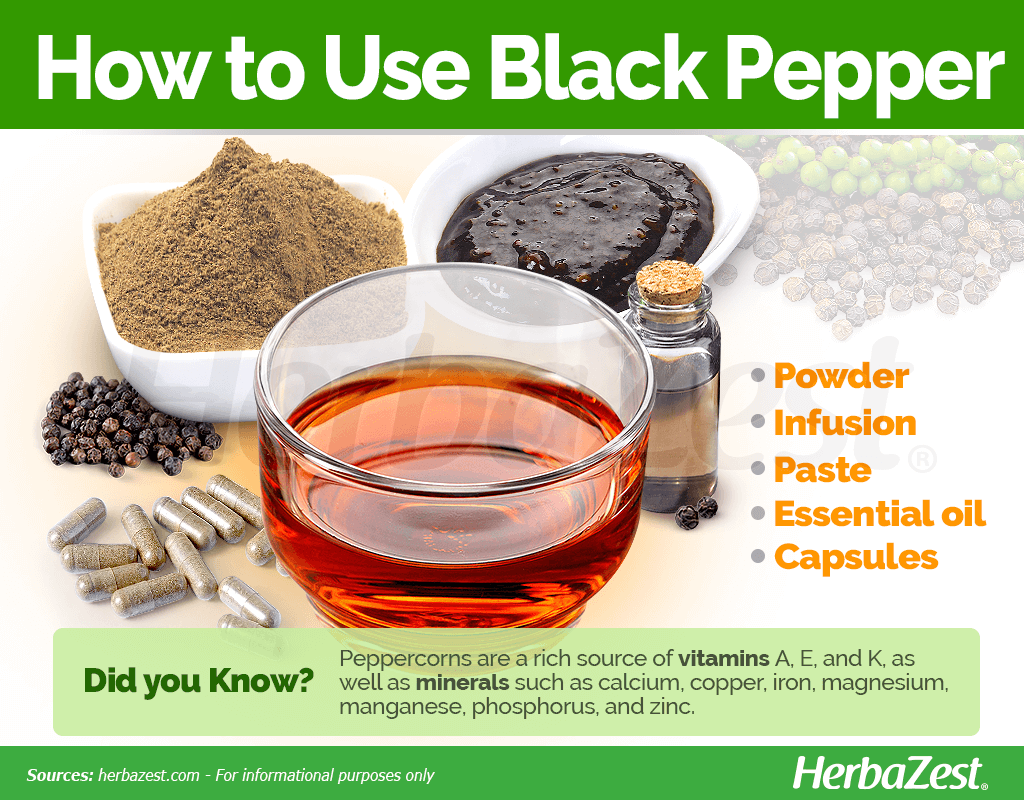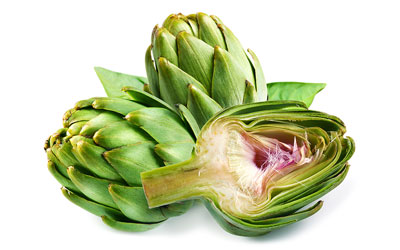Black pepper was once one of the most traded spices worldwide, often referred to as “black gold” because it was used as currency throughout the commercial routes between Europe and India. Since then, a myriad of health benefits and medicinal uses have been uncovered for the pepper plant, from which black, white, and green peppercorns come from.
Black Pepper Medicinal Properties
Health Benefits of Pepper
Used as both a spice and medicine worldwide, pepper offers an array of vitamins and minerals. It is a rich source of vitamins A, E, and K, as well as the minerals calcium, copper, iron, magnesium, manganese, phosphorus, and zinc. The antioxidants found in pepper positively affect the body in a variety of ways, including:
Improving digestion. Pepper increases the absorption of several vitamins and minerals and stimulates saliva secretion to ultimately assist with the breakdown of food within the digestive system.
Preventing chronic diseases. Black pepper is able to increase the bioavailability of other foods and drugs, thus potentiating their effects within the body and stimulating the immune system. Pepper is high in antioxidants, which help the body fight against oxidative stress and harmful pathogens.
How It Works
Piperine, a pungent alkaloid found in pepper, helps increase the absorption of selenium, B-group vitamins, and beta-carotene, among other nutrients. Piperine has been shown to stimulate the digestive enzymes whitin pancreas, enhancing digestion.1 It also helps stimulate saliva secretion, which increases the production of digestive juices, responsible for breaking down proteins, increasing digestibility and reducing the possibility of heartburn and other gastrointestinal issues.
Piperine also increases the bioavailability of certain compounds.2 This is especially true when it comes to curcumin, the active compound of turmeric that helps fight inflammation. Studies have shown that piperine enhances the absorption (bioavailability) and serum concentration of curcumin in both animals and humans with no unfavorable side effects.3 Piperine also interferes with inflammatory signaling mechanisms and inhibits pro-inflammatory cytokines4, which are small proteins secreted by some cells and linked with a number of degenerative diseases.
Moreover, black pepper's antioxidant content helps the body to fight and repair the free radicals' damage5 that contribute to cardiovascular diseases, inflammation, and more.
PEPPER CAN HELP THE BODY FIGHT AGAINST OXIDATIVE STRESS.
Immune stimulant properties are also present in herbs like echinacea, camu camu, and soursop; whereas cinnamon, cloves, and oregano provide similar digestive effects.
Pepper Side Effects
Pepper may cause sneezing if inhaled and a burning aftertaste if consumed in excess.
Like most other fruits and vegetables, it should not be consumed in high concentrations. It is mostly likely safe to use moderate amounts of black or white pepper in food. If signs of an allergic reaction appear, consult with a trusted medical professional.
Pepper Cautions
There is a risk of skin sensitivity for those who apply black pepper essential oil topically. Keep it out of reach of children, and avoid contact with the eyes, ears, and any other sensitive area.
Those who are pregnant, breastfeeding, taking medications, or under a doctor's care should consult a physician before using black pepper essential oil.
Also, those who have ulcers or have undergone abdominal surgery should avoid pepper consumption, since it may irritate the intestines.
- Medicinal action Digestive, Immunostimulant
- Key constituents Piperine, antioxidants
- Ways to use Hot infusions/tisanes, Freshly ground, Essential oil
- Medicinal rating (2) Minorly useful plant
- Safety ranking Use with caution
How to Consume Black Pepper
Black pepper is the most commonly used spice around the world. It is enjoyed in a wide variety of culinary dishes; however, peppercorns also have medicinal applications and can be made into remedies.
Natural Forms
Dried. Hot, pungent, and spicy peppercorns are from black pepper, However, any form of pepper can be used in meat dishes, sauces, and other types of food.
Powder. The dried peppercorns are commonly pulverized to be used in culinary and medicinal forms. In this way all the black pepper benefits can be equally obtained.
Infusion. The infusion of pepper is thought to help relieve the symptoms of arthritis, fever, headaches, strep throat, and poor digestion.
Paste. Black pepper paste can be applied to treat hair loss and some skin diseases, while white pepper paste is thought to be useful for treating eye diseases.
Herbal Remedies & Supplements
Essential oil. The alkaloids in the oil obtained from cold-pressed peppercorns are believed to help with pain relief, flu, colds, muscular aches, and fevers, as well as enhancing circulation. It is best to apply black pepper essential oil topically, mixed with a carrier oil.
Capsules. Black pepper can be found in supplemental forms, mixed with other herbs, such as turmeric, in order to aid their absorption.
- Edible parts Seed
- Edible uses Flavoring, Condiment
- Taste Spicy, Pungent
Growing
The black pepper plant is a flowering, woody, perennial climbing vine that typically grows in the tropical forests of India, but it is also a valuable crop in different parts of the world. Wherever it is cultivated, the so-called “king of spices” needs some specific requirements to thrive.
Growing Guidelines
The black pepper plant is propagated through seeds and cuttings.
Black pepper requires high humidity and generous watering. It doesn't tolerate excessive heat and dryness.
The crop tolerates temperatures that are between 50 - 104°F (10 - 40°C).
This vine grows best in well-drained, loamy soils that are high in organic matter and rich in humus.
The black pepper plant requires partial shade in order to not turn yellow. The top portion of the vine receives more sunlight than the rest, but the rest of the plant is mutually shaded on down.
This vine requires living or nonliving standards for support and successful growth.
One of the most prominent pepper viruses is the cucumber mosaic virus. Other diseases include tobacco etch, tomato spotted wilt, potato virus, pepper mottle, and alfalfa mosaic virus.
More detailed information about growing black pepper can be found in our herb garden section.
- Life cycle Perennial
- Harvested parts Seeds
- Light requirements Partial shade
- Soil Loamy sand, Well-drained
- Soil pH 6.6 – 7.3 (Neutral)
- Growing habitat Tropical rainforests
- Planting time Early spring
- Propagation techniques Root cuttings
- Potential insect pests Beetles
- Potential diseases Cucumber mosaic virus
Additional Information
Plant Biology
Pepper plants have dark green, almond-shaped leaves that are two to four inches (5 - 10 cm) in length and about one to two and a half inches (3 - 6 cm) in width, alternately arranged.
The inconspicuous, petal-less pepper flowers grow in clusters along the flowering stalks or spikes, which are nearly as long as the leaves. The length of the spikes goes from about three to six inches (7 - 15 cm). Each fruit or drupe on the spike contains a single seed. Drupes starts green and then ripen into a dark red color. There are up to 60 drupes on each spike.
The collected spikes are sun-dried to separate the peppercorns. There are three different types of peppers that can be created from a single drupe depending on when the fruit is harvested and how it's processed. The freshly harvested, unripe green fruits may freeze-dry to make green pepper. Drupes that are picked when fully grown but still green are sun-dried and used as black pepper. When the drupes are slightly riper, they're used to produce white pepper. These are soaked to remove the fleshy red skin so that the stony seeds can be sun-dried to make white pepper.
Classification
The botanical name of black pepper is Piper nigrum, and it belongs to the pepper family (Piperaceae), which consists of four genera and about 2000 species, all of them native to the tropics. It is important to mention that in the past all Capsicum anuum cultivars, such as cayenne, chili pepper, and bell pepper, were included in this family but later separated, since they are not true peppers at all but members of the nightshade family (Solanaceae).
Related Species and Cultivars of Black pepper
The Piper genus comprises over 1000 species, some of them of medicinal and economical importance, such as matico (P. aduncum), long pepper (P. longum) and kava kava (P. methysticum).
Out of the over 100 cultivars of black pepper, few are high- and stable-yielding. Moreover, each pepper-producing country has identified and cultivated varieties most suitable for its growing region. For example, over 75 cultivars are grown in India, and many are tolerant to a prevalent root rot known as Phytophthora. Some popular Indian cultivars include 'Karimunda', 'Neelamundi', and 'Kottanadan', among others.
Historical information
Black pepper is one of the earliest spices used by mankind, and it is native to southern India, where it grows wildly. It started moving westward about 4,000 years ago. It was one of the most widely-traded spices in the world and is often referred to as “black gold” and the “king of spices,” seeing as it was used as commodity money throughout the trading world between Europe and India.
During the middle ages, the price of pepper was exorbitantly high. Therefore, pepper in Europe was one of the most esteemed and important spices, often used as a medium of exchange when money was short.
Nowadays, it is cultivated all over tropical areas as a commercial crop.
Economic Data
On average, about 260,000 tons of pepper are traded yearly on the global market. Vietnam is the number-one exporter of the spice, with over 96,000 tons in 2004, valued at $136.6 million USD in the United States. The major worldwide producers are India, Indonesia, Brazil, and Vietnam.
Peppercorns that originate from Kerala, India are particularly noted for their flavor and pungency. India produces about 10% of the peppercorn in the world market.
Other Uses of Black Pepper
Insecticide. Pepper has also been used for non-medical applications, such as a natural insecticide.
Pepper has a variety of medicinal uses aside from its culinary uses already complemented by its most popular partner, salt. Pepper's antioxidants and alkaloids help with improving digestion and preventing the occurrence of chronic diseases. From its long history to today, pepper serves as a promising spice in any cuisine.
- Other uses Repellent
Sources
- Black Pepper Essential Oils, p. 14 - 15
- Chemistry of Spices, p. 2, 21 - 40
- Cornell University, Vegetable Crops: Virus Diseases of Pepper
- Current Neuropharmacology, Oxidative Stress and Neurodegenerative Diseases: A Review of Upstream and Downstream Antioxidant Therapeutic Options, 2009
- Health Benefits: From Foods and Spices, p. 348 - 351
- Journal of Spices and Aromatic Crops, Agronomy of black pepper (Piper nigrum L.) – a review, 1999
- Medicinal & Aromatic Plants, A Review on Therapeutic Potential of Piper nigrum L. (Black Pepper): The King of Spices, 2014
- New Methods of Food Preservation, p. 66
- Open Access Scientific Reports, Nutritional Constituent of Black Pepper as Medicinal Molecules: A Review, 2012
- Pepper Production Guide for Asia and The Pacific, Pepper Varieties
- Pharmacographia: A History of the Principal Drugs of Vegetable Origin, p. 519 - 524
- Plant Sciences Review, p. 38
- Purdue University, Center for New Crops & Plants Products, Pepper
- Studies in Natural Products Chemistry, Volume 43, p. 106
- The Bone Broth Secret
- The Encyclopedia of Healing Foods, p. 203
- Tropical Shrubs, pp. 1 - 2
- University of Connecticut, Piper nigrum L.
- Kew Royal Botanic Gardens, Piper nigrum (black pepper)
- Pharmacognosy Reviews, Free radicals, antioxidants and functional foods: Impact on human health, 2010
Footnotes:
- Critical Reviews in Food Science and Nutrition. (2007). Black pepper and its pungent principle-piperine: a review of diverse physiological effects. Retrieved June 9, 2023, from: https://pubmed.ncbi.nlm.nih.gov/17987447/
- Journal of Ayurveda and Integrative Medicine. (2010). Bioenhancers: Revolutionary concept to market. Retrieved June 9, 2023, from: https://www.ncbi.nlm.nih.gov/pmc/articles/PMC3151395/
- Planta Medica. (1998). Influence of piperine on the pharmacokinetics of curcumin in animals and human volunteers. Retrieved June 9, 2023, from: https://pubmed.ncbi.nlm.nih.gov/9619120/
- Heliyon. (2020). Application of film-forming solution as a transdermal delivery system of piperine-rich herbal mixture extract for anti-inflammation. Retrieved June 9, 2023, from: https://www.ncbi.nlm.nih.gov/pmc/articles/PMC7292918/
- Methods and Findings in Experimental and Clinical Pharmacology. (2000). In vitro antioxidant activity of piperine. Retrieved June 9, 2023, from: https://pubmed.ncbi.nlm.nih.gov/11031726/












